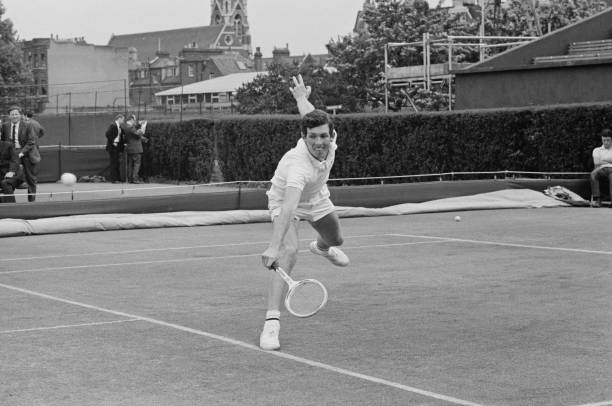The pace of the tennis calendar in 1973 was unremitting. After the Australian Open, most of the best men played the 15-week World Championship Tennis slate. While the WCT point leaders convened for the tour finals in Montreal and Dallas, many of the others scattered around the globe to play Davis Cup. With one week to go before the start of the French Open, a bit of rest and recuperation must have been in order.
Except… Tennis-loving comedian Alan King set up a tournament at Caesar’s Palace in Las Vegas, to be run by the semi-retired Richard González. Glitz, glamour, and–oh yes–a record-setting $150,000 in prize money. The winner would walk away with $30,000.
Who could say no to that? Aside from European stars committed to play Davis Cup on the Continent, the answer was, approximately, no one. Stan Smith and Arthur Ashe, the last two men standing at the WCT Finals in Dallas, showed up. Rod Laver and Ken Rosewall, too. John Newcombe, who had skipped the WCT circuit in favor of leading the Australian Davis Cup team through its preliminary rounds in Asia, rejoined the fray.
The Vegas event marked a transition for the men’s tour. It was the first tournament run under the auspices of the Association of Tennis Professionals (ATP), the players’ organization founded the previous September. Until that point, the best players typically competed under contract to a circuit, like billionaire Lamar Hunt’s WCT tour. The alternative was to register as an independent pro and play at events sponsored by national federations around the world. The latter course offered more flexibility, but the real money was in the contracts. Thanks to WCT, Laver was a millionaire, and Smith was $50,000 richer after winning the 1973 Finals.
The ATP didn’t set out to displace the WCT, and it wouldn’t do so anytime soon. The primary goal was to give athletes a bigger say in the running of the sport. It would shift the balance away from the national federations that had controlled players’ fates in the amateur era. Those organizations, together with their parent group, the International Lawn Tennis Federation (ILTF), clung to whatever authority they could.
No federations were involved in the making of the $150,000 Alan King/Caesar’s Palace Tennis Classic.
Whatever independence players could achieve, they could not free themselves from the realities of the calendar. On May 15th, top seed Smith lost his opening match to journeyman South African Ray Moore. The same day, second seed Laver fell to big-serving countryman Dick Crealy, crashing out in a 6-0 third set.
“It’s like playing Forest Hills the week after Wimbledon,” Smith said of the Dallas-to-Vegas transition. It was worse than that: Most of the events of the previous four months had been held indoors. Matches in Vegas were outdoors in 95-degree heat.
Laver had an even better excuse. The 34-year-old was physically spent. After coping for weeks with a back injury that hampered his normally awe-inspiring serve, he didn’t trust his body to make his usual service motion. Against Crealy, he missed more first serves than he made.
For the first time in 15 years, the man needed a break. He told the press after the match that he would take “a few months off.” He would miss the French, the Italian, and quite possibly Wimbledon as well.
The Las Vegas first round claimed one more victim of note: Niki Pilić, the 33-year-old veteran from Yugoslavia. He had opted to chase the $150,000 instead of playing Davis Cup against New Zealand in Zagreb. When Pilić lost in straight sets to American Cliff Richey, no one paid much heed. There wasn’t much interest in the new players’ association, either.
That would change. Within a month, the Yugoslavian and the rebels of the ATP would be the biggest names in tennis.
* * *
This post is part of my series about the 1973 season, Battles, Boycotts, and Breakouts. Keep up with the project by checking the TennisAbstract.com front page, which shows an up-to-date Table of Contents after I post each installment.
You can also subscribe to the blog to receive each new post by email:
